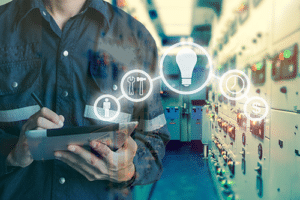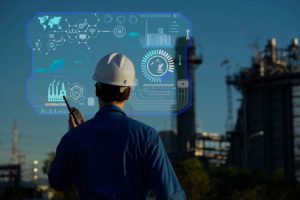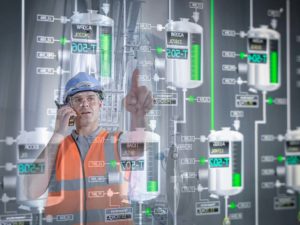In industrial spaces, the term “artificial intelligence” triggers a mix of dread, hope, and eye-rolls. Will this new Industrial AI tech eventually learn from data quicker than humans can? Will the hype ever match up with reality? While there are still plenty of unknowns, we can now see where we are going based on where we have been.
What is Industrial AI?
In plain English, artificial intelligence (colloquially known as AI, or industrial AI) is the ability of a computer to perform tasks commonly associated with intelligent beings.”1 Though, if Hollywood controlled the Encyclopedia, we’d think AI only meant entities like Terminator or Hal.
However, AI doesn’t need to be self-aware or destruction-bent.
Today, there are only a few true examples of Industrial AI in the current marketplace. IBM’s Watson is the beginning of Industrial AI, but it (like most others) isn’t exactly Industrial AI. They are technologies that are precursors to full-fledged Industrial AI, ones that will lay the foundation for the AI-enhanced future.
The History of Industrial AI

There are now modern AI that rival, or blow past, human intelligence when it comes to specific tasks — and, no, it’s not called Skynet.
What are Current Industrial AI Applications?
We may not have personal AI robots to do our house chores, run our plants, or handle routes in our facilities, but that doesn’t mean AI isn’t already here. Cortana, Siri, and Bixby are all personal AI technologies that augment human actions with data inferences. They aren’t robots, though. And, while personal assistants are great, they aren’t Industrial AI.
AI and robotics also aren’t the same. A robot can perform physical functions like humans but can’t necessarily make an independent analysis. An AI is a computer program that analyzes and infers outcomes from massive amounts of data.

Credit: Getty Images
Robotics has been in virtually every manufacturing space for the past several decades. And industrial AI is already making inferences from industrial data to augment human actions..
However, Artificial Intelligence is already talking to us. Organizations around the globe use AI-programmed Chatbots to converse in a way similar to humans. Engineers are programming AI to autonomously fly or drive vehicles. More than merely being automated, autonomous technologies can change course based on new data, whether user input (flicking a turn signal) or external sensors (a visual reading of a person).
AI Impacts within Industrial Spaces
Artificial intelligence is already working within industrial spaces, though not as full-fledged as many would believe. The impact of industrial AI will be first seen in preventive maintenance practices that lead to predictive maintenance strategies. AI is the crux of the prescriptive maintenance future.
Already, condition monitoring software can infer a machine’s health from historical and real-time measurements. With the help of condition monitoring sensors, like vibration monitors, the software provides a “stoplight” color to reference whether an asset is good (green), on the verge (yellow), or experiencing a functional failure (red). These systems usually only use one type of source (such as a vibration sensor or thermal reading) to provide analysis, not a multitude of sources.
What is Needed to Implement Industrial AI in Operations?

Credit: Getty Images
At Fluke Reliability, we’re on the path to an AI-infused maintenance and reliability program. Our engineers are testing the power of data analytics and artificial intelligence computing to infer when you need to take maintenance actions, such as replacing components or checking lubricants. Our programs already digest and analyze data from condition monitoring sensors to determine what your assets need and when they need it. The next step is to inform users of precise steps to remedy asset ills.
We realized along the way, that there are three keys to an AI-augmented maintenance program.
- Digitized facilities and equipment
Using a computerized maintenance management system (CMMS) or enterprise asset management (EAM) software to recreate assets, buildings, and more in a digital space. - Big Data
Aggregating and storing massive amounts of data will lead to improved machine learning. Sources can be aftermarket or OEM condition monitoring sensors, tools, or practices. - Trusted Software Partner
An organization that is lives in the now, while planning for an AI-filled future. One that will be with you through the entire digitization, reliability, and AI implementation process.
Fluke Reliability is already in the CMMS/EAM space, helping workers improve maintenance practices. But we’re also engineering IIoT hardware, analysis software, industry-leading services, best practices, and principles that will help make the maintenance efforts of tomorrow easier, leaner, and more efficient.
Our Industrial AI Future
Putting Hollywood tropes aside, AI is already here and Industrial AI will be in your industrial workspace very soon. Like any technology, how we leverage it will indicate whether it’s a net positive or negative.
—
Citations:
- Copeland, B. J. “Artificial Intelligence | Definition, Examples, and Applications.” Encyclopedia Britannica, 11 Sept. 2021, britannica.com/technology/artificial-intelligence.
- Kissinger, Henry, et al. The Age of A. I.: And Our Human Future. Little Brown & Company, 2021.
